Recovering Nimrud: Smithsonian’s Projects in Iraq
By Bowdoin College Museum of ArtLearn more about the important work being done at Nimrud by the Smithsonian, in collaboration with Iraqi cultural heritage partners and the US Department of State, in this video which was shared during the lecture.
Earlier this month, Smithsonian experts in cultural heritage Corine Wegener and Jessica Johnson visited Bowdoin to deliver the annual lecture supported by the Yadgar Family Endowment. During their time on campus, Corine and Jessica visited Bowdoin classes, lunched with students, and met with members of the BCMA team to discuss ongoing cultural heritage projects at the Smithsonian and in Brunswick. In their public talk, “Recovering Nimrud: Smithsonian's Projects in Iraq,” Corine and Jessica shared an overview of the cultural heritage work that the Smithsonian is involved in around the world and updates on the fieldwork currently underway at the site of Nimrud in Iraq. Stressing the global significance of Iraq’s cultural heritage, the duo shared how the Smithsonian is partnering today with Iraqis to conduct conservation fieldwork and provide training in Iraq. Their work is covered in this video, which was shared during the lecture:
Bowdoin College is proud to serve as stewards of important ancient cultural heritage from the site of Nimrud in the form of the five Assyrian reliefs sent by Dr. Byron Henri Haskell in 1860. Asked about ways the BCMA and the community could support cultural heritage abroad, Corine and Jessica pointed to efforts like the exhibition Assyria to America, which is on view until December 13, 2020, as critical to creating public awareness of the significance of Iraqi history and cultural heritage, and providing context and support for the work they do in Iraq.
Both Corine and Jessica shared insights about their path to the field of cultural heritage and their motivations for pursuing this difficult but important work. With a background in art history, Corine Wegener serves as director of the Smithsonian Cultural Rescue Initiative (SCRI) and is a founder of the U.S. Committee of the Blue Shield dedicated to raising awareness of the 1954 Hague Convention for the Protection of Cultural Property. In 2003, while serving as a US Army Reserve officer, Corine was one of the earliest Americans on the ground in the wake of looting of the Iraq National Museum in Baghdad. As an Arts, Monuments, and Archives Officer (colloquially known as the “Monuments Men”), Corine supported efforts to document and preserve artifacts in the immediate aftermath of the looting. Today, Corine continues this important work, leading the SCRI’s efforts to assist in response to natural and manmade disasters around the world, including in 2010 Haiti earthquake and responding to the destruction of cultural heritage by ISIS in Iraq and Syria.
Trained in conservation science, Jessica Johnson previously served as a senior conservator at the National Museum of the American Indian. Together with American and Iraqi colleagues, Jessica helped found the Iraqi Institute for the Conservation of Antiquities and Heritage in Erbil, which provides training in cultural heritage and conservation practice for Iraqis and is engaged in onsite conservation work at Nimrud the 2016 destruction of the site by ISIS. As the Head Conservator for Smithsonian’s Museum Conservation Institute, Jessica continues to travel to Iraq and help lead the Smithsonian’s efforts to collaborate with Iraqi professionals for the conservation of Iraqi cultural heritage.
Corine and Jessica also joined two Bowdoin classes during their visit to campus. They spoke with students in Professor Willi Lempert’s anthropology course “Ethnographic Research” and shared the team-based approach to cultural heritage they employ. Emphasizing the range of training and expertise cultural heritage work draws on in the field, from art historians to military command, Corine and Jessica shared personal experiences that highlight the possibilities and challenges in creating relationships across cultural and professional divides. According to Professor Lempert, the class visits “not only provided a way for students to understand museological methods, but it also engaged them in a complex discussion of practical ethics in the aftermath of war and cultural destruction.”
Later, Corine and Jessica visited Professor Barbara Elias’s government course on “Counterinsurgencies” to share with the students their experiences in Iraq in the wake of the American ground invasion in 2003. Professor Elias reflected on the visit, sharing that “making the connection between the political dynamics of the modern Middle East and the work of the Smithsonian on historic preservation was an exquisite example of interdisciplinary work at Bowdoin, bringing together anthropology, archaeology, history, and government.”
Sean P. Burrus, Andrew W. Mellon Postdoctoral Fellow
Bowdoin College Museum of Art

The speakers enjoyed a visit to the Assyrian Gallery in the Bowdoin College Museum of Art during their visit. Left to right: Anne Collins Goodyear, co-director; Frank Goodyear, co-director; Sean Burrus, Andrew W. Mellon Postdoctoral Fellow; Corine Wegener, director of the Smithsonian Cultural Rescue Initiative (SCRI); Jessica Johnson, head conservator for Smithsonian’s Museum Conservation Institute; and Brooke Wrubel ’21, student curatorial assistant.